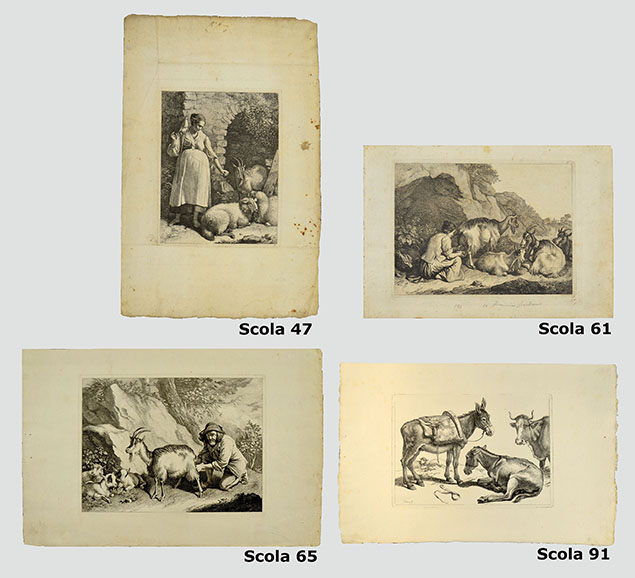(Milan 1723 - 1783)
FOUR PASTORAL SCENES, 1760 - 1764
Scola 47, FILATRICE PRESSO UN ARCO. 1764. Etching Signed in the plate Fran. Londonio F. Napoli 1764. First of a series of six etchings executed partly in Milan, partly in Rome and Naples between 1760 and 1764. Fine impression of the II state of 3 after the appearance of the number 1 in the lower right margin. To the platemark 243 x 190 mm, the full sheet 465 x 305 mm. Large margins, traces of folds and some brown spots on the right margin.
Scola 61, PASTORELLA CHE MUNGE UNA CAPRA. 1763-1764. Etching, from a series of twelve dedicated to Lord Exeter and executed in Naples between 1763 and 1764. Fine impression of the I state of 2, before the appearance of Londonio's name on the left, under the etched area. To the platemark 215 x 287 mm, the full sheet 270 x 338 mm. Traces of binding on the left and slight traces of use.
Scola 65, VECCHIO PASTORE CHE MUNGE UNA CAPRA. 1776-1779. Etching, a fine impression of the I state of 2, before any inscription. To the platemark 218 x 285 mm, the full sheet 305 x 465 mm. Wide margins, in fine condition.
Scola 91, DUE ASINI, MUCCA E PECORA. Etching, signed in the plate Londonio f, from a series of 6 plates edited by Prince Alberico da Barbiano after Londonio's death. Fine impression of the I state of 3 before the appearance of number 4 in the lower right corner and before the inscriptions. To the platemark 175 x 250 mm, the full sheet 278 x 430 mm. Wide margins, in fine condition.
Londonio trained as a painter under Ferdinando Porta and Giovanni Battista Sassi in Milan, but traveled to Rome and Naples. He studied engraving with Benigno Bossi. He is best known for his paintings and etchings of rustic and pastoral landscapes and subjects, with both animals and peasants playing a dominating role over the landscape. This focus on genre themes was popular among the wealthy patrons of the time, specially in Northern Italy. He mostly preferred small-format works, describing shepherds and peasants with rapid strokes of the brush and with a vigorous and chromatically lively pictorial paste. His talent allowed him to be one of the most appreciated painters of reality active in Lombardy, between Arcadia and the Enlightenment.
Londonio is also known for his scenography. An example, of this poorly conserved art form that still exists is a nativity scene on cut wooden shapes for the church of San Marco in Milan. The effect is a cheaper version of the naturalistic Sacri Monti scenes, which had been painted stucco statuary. It also can be seen as a cross between the holy scenes described above, and the theatrical set pieces, for example, those needed for the newly founded La Scala theater. The work at San Marco prompted Empress Maria Theresa of Austria appointed Londonio as art designer for La Scala.
